
In this video segment from WGBH, children experiment with cardboard and build a house for their stuffed animals.
- Subject:
- Career and Technical Education
- Mathematics
- Material Type:
- Audio/Video
- Provider:
- PBS LearningMedia
- Date Added:
- 11/06/2023

In this video segment from WGBH, children experiment with cardboard and build a house for their stuffed animals.

In this video segment adapted from ZOOM, cast members enter the FIRST LEGO League Challenge tournament and work as a team to program their LEGO robot to navigate a complex obstacle course. [6:01]
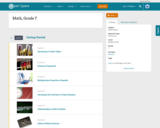

Zooming In On Figures
Unit Overview
Type of Unit: Concept; Project
Length of Unit: 18 days and 5 days for project
Prior Knowledge
Students should be able to:
Find the area of triangles and special quadrilaterals.
Use nets composed of triangles and rectangles in order to find the surface area of solids.
Find the volume of right rectangular prisms.
Solve proportions.
Lesson Flow
After an initial exploratory lesson that gets students thinking in general about geometry and its application in real-world contexts, the unit is divided into two concept development sections: the first focuses on two-dimensional (2-D) figures and measures, and the second looks at three-dimensional (3-D) figures and measures.
The first set of conceptual lessons looks at 2-D figures and area and length calculations. Students explore finding the area of polygons by deconstructing them into known figures. This exploration will lead to looking at regular polygons and deriving a general formula. The general formula for polygons leads to the formula for the area of a circle. Students will also investigate the ratio of circumference to diameter ( pi ). All of this will be applied toward looking at scale and the way that length and area are affected. All the lessons noted above will feature examples of real-world contexts.
The second set of conceptual development lessons focuses on 3-D figures and surface area and volume calculations. Students will revisit nets to arrive at a general formula for finding the surface area of any right prism. Students will extend their knowledge of area of polygons to surface area calculations as well as a general formula for the volume of any right prism. Students will explore the 3-D surface that results from a plane slicing through a rectangular prism or pyramid. Students will also explore 3-D figures composed of cubes, finding the surface area and volume by looking at 3-D views.
The unit ends with a unit examination and project presentations.
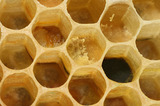
Students will resume their project and decide on dimensions for their buildings. They will use scale to calculate the dimensions and areas of their model buildings when full size. Students will also complete a Self Check in preparation for the Putting It Together lesson.Key ConceptsThe first part of the project is essentially a review of the unit so far. Students will find the area of a composite figure—either a polygon that can be broken down into known areas, or a regular polygon. Students will also draw the figure using scale and find actual lengths and areas.GoalsRedraw a scale drawing at a different scale.Find measurements using a scale drawing.Find the area of a composite figure.SWD: Consider what supplementary materials may benefit and support students with disabilities as they work on this project:Vocabulary resource(s) that students can reference as they work:List of formulas, with visual supports if appropriateClass summaries or lesson artifacts that help students to recall and apply newly introduced skillsChecklists of expectations and steps required to promote self-monitoring and engagementModels and examplesStudents with disabilities may take longer to develop a solid understanding of newly introduced skills and concepts. They may continue to require direct instruction and guided practice with the skills and concepts relating to finding area and creating and interpreting scale drawings. Check in with students to assess their understanding of newly introduced concepts and plan review and reinforcement of skills as needed.ELL: As academic vocabulary is reviewed, be sure to repeat it and allow students to repeat after you as needed. Consider writing the words as they are being reviewed. Allow enough time for ELLs to check their dictionaries if they wish.

This lesson has a new approach to vocabulary building where students generate their own vocabulary word lists and research the words' meanings.
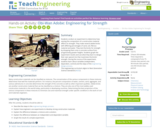
Students conduct an experiment to determine how varying the composition of a construction material affects its strength. They make several adobe bricks with differing percentages of sand, soil, fibrous material and water. They test the bricks for strength by dropping them onto a concrete surface from progressively greater heights. Students graph the experiment results and use what they learn to design their own special mix that maximizes the bricks' strength. During the course of the experiment, students learn about variables (independent, dependent, control) and the steps of the engineering design process.

A collection of resources about bridges that includes basic facts about bridges, challenges faced by bridge builders, famous bridges from around the world, and a lab that helps you understand how different forces affect bridge construction. Also includes links to recommended websites on related topics.

A site for all users interested in the engineering behind the building. Site engages users in a job that requires them to investigate troubled buildings and then figure out how to fix them.
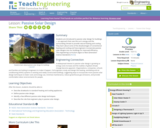
Students are introduced to passive solar design for buildings an approach that uses the sun's energy and the surrounding climate to provide natural heating and cooling. They learn about some of the disadvantages of conventional heating and cooling and how engineers incorporate passive solar designs into our buildings for improved efficiency.

Travel back to 1914 when Chicago's skyscrapers and Chicago's poets were defining modernist reach and audacity. In this video [7:46] excerpted from Poetry in America, host Elisa New considers the rise of the skyscraper -- and the emergence of the modernist poem -- in an episode featuring celebrated architect Frank Gehry, Chinese visionary and real estate developer Zhang Xin, poet Robert Polito, and student poets from around the United States. And what about today? Can a building, as Sandburg asserts, have "soul," and who gives it that soul?
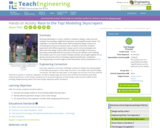
Working individually or in pairs, students compete to design, create, test and redesign free-standing, weight-bearing towers using Kapla(TM) wooden blocks. The challenge is to build the tallest tower while meeting the design criteria and minimizing the amount of material used all within a time limit. Students experiment with different geometric shapes used in structural designs and determine how design choices affect the height and strength of structures, becoming comfortable with the concepts of structural members and modeling.
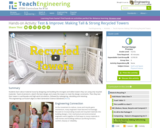
Students learn about material reuse by designing and building the strongest and tallest towers they can, using only recycled materials. They follow design constraints and build their towers to withstand earthquake and high wind simulations.
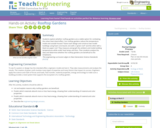
Students explore whether rooftop gardens are a viable option for combating the urban heat island effect. Can rooftop gardens reduce the temperature inside and outside houses? Teams each design and construct two model buildings using foam core board, one with a "green roof" and the other with a black tar paper roof. They measure and graph the ambient and inside building temperatures while under heat lamps and fans. Then students analyze the data and determine whether the rooftop gardens are beneficial to the inhabitants.
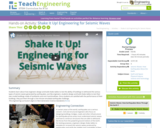
Students learn about how engineers design and build shake tables to test the ability of buildings to withstand the various types of seismic waves generated by earthquakes. Just like engineers, students design and build shake tables to test their own model buildings made of toothpicks and mini marshmallows. Once students are satisfied with the performance of their buildings, they put them through a one-minute simulated earthquake challenge.
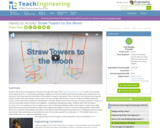
Students learn about civil engineers and work through each step of the engineering design process in two mini-activities that prepare them for a culminating challenge to design and build the tallest straw tower possible, given limited time and resources. First they examine the profiles of the tallest 20 towers in the world. Then in the first mini-activity (one-straw tall tower), student pairs each design a way to keep one straw upright with the least amount of tape and fewest additional straws. In the second mini-activity (no "fishing pole"), the pairs determine the most number of straws possible to construct a vertical straw tower before it bends at 45 degrees—resembling a fishing pole shape. Students learn that the taller a structure, the more tendency it has to topple over. In the culminating challenge (tallest straw tower), student pairs apply what they have learned and follow the steps of the engineering design process to create the tallest possible model tower within time, material and building constraints, mirroring the real-world engineering experience of designing solutions within constraints. Three worksheets are provided, for each of two levels, grades K-2 and grades 3-5. The activity scales up to school-wide, district or regional competition scale.

Students use a table-top-sized tsunami generator to observe the formation and devastation of a tsunami. They see how a tsunami moves across the ocean and what happens when it reaches the continental shelf. Students make villages of model houses and buildings to test how different material types are impacted by the huge waves. They further discuss how engineers design buildings to survive tsunamis. Much of this activity setup is the same as for the Mini-Landscape activity in Lesson 4 of the Natural Disasters unit.

Clickable network map shows information on the types and uses of networking hardware. Very basic introduction.